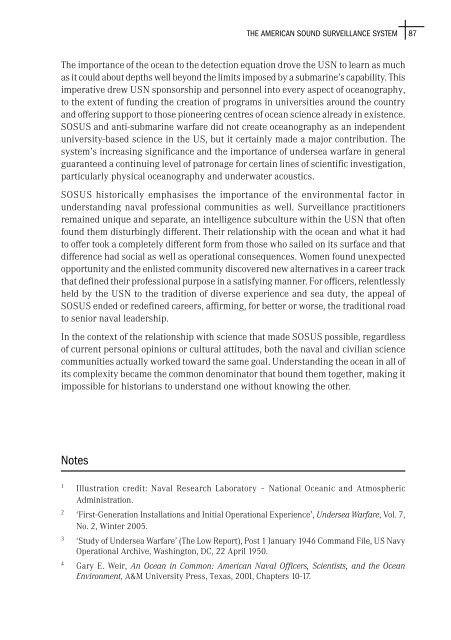Australian Maritime Issues 2007 - Royal Australian Navy
Australian Maritime Issues 2007 - Royal Australian Navy
Australian Maritime Issues 2007 - Royal Australian Navy
Create successful ePaper yourself
Turn your PDF publications into a flip-book with our unique Google optimized e-Paper software.
The American Sound Surveillance System<br />
87<br />
The importance of the ocean to the detection equation drove the USN to learn as much<br />
as it could about depths well beyond the limits imposed by a submarine’s capability. This<br />
imperative drew USN sponsorship and personnel into every aspect of oceanography,<br />
to the extent of funding the creation of programs in universities around the country<br />
and offering support to those pioneering centres of ocean science already in existence.<br />
SOSUS and anti-submarine warfare did not create oceanography as an independent<br />
university-based science in the US, but it certainly made a major contribution. The<br />
system’s increasing significance and the importance of undersea warfare in general<br />
guaranteed a continuing level of patronage for certain lines of scientific investigation,<br />
particularly physical oceanography and underwater acoustics.<br />
SOSUS historically emphasises the importance of the environmental factor in<br />
understanding naval professional communities as well. Surveillance practitioners<br />
remained unique and separate, an intelligence subculture within the USN that often<br />
found them disturbingly different. Their relationship with the ocean and what it had<br />
to offer took a completely different form from those who sailed on its surface and that<br />
difference had social as well as operational consequences. Women found unexpected<br />
opportunity and the enlisted community discovered new alternatives in a career track<br />
that defined their professional purpose in a satisfying manner. For officers, relentlessly<br />
held by the USN to the tradition of diverse experience and sea duty, the appeal of<br />
SOSUS ended or redefined careers, affirming, for better or worse, the traditional road<br />
to senior naval leadership.<br />
In the context of the relationship with science that made SOSUS possible, regardless<br />
of current personal opinions or cultural attitudes, both the naval and civilian science<br />
communities actually worked toward the same goal. Understanding the ocean in all of<br />
its complexity became the common denominator that bound them together, making it<br />
impossible for historians to understand one without knowing the other.<br />
Notes<br />
1<br />
Illustration credit: Naval Research Laboratory – National Oceanic and Atmospheric<br />
Administration.<br />
2<br />
‘First-Generation Installations and Initial Operational Experience’, Undersea Warfare, Vol. 7,<br />
No. 2, Winter 2005.<br />
3<br />
‘Study of Undersea Warfare’ (The Low Report), Post 1 January 1946 Command File, US <strong>Navy</strong><br />
Operational Archive, Washington, DC, 22 April 1950.<br />
4<br />
Gary E. Weir, An Ocean in Common: American Naval Officers, Scientists, and the Ocean<br />
Environment, A&M University Press, Texas, 2001, Chapters 10-17.
















